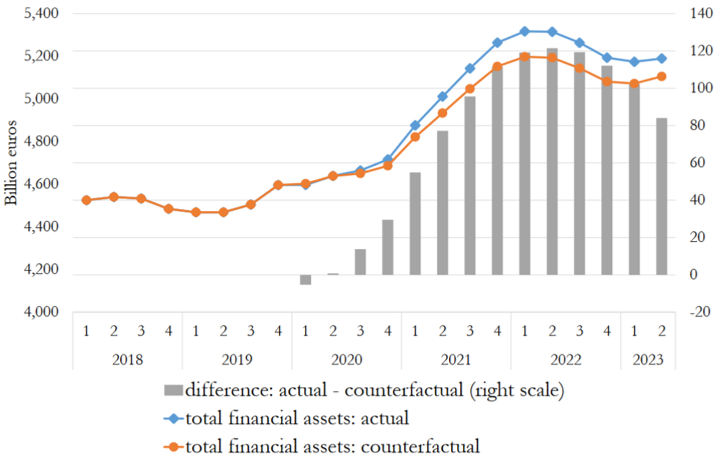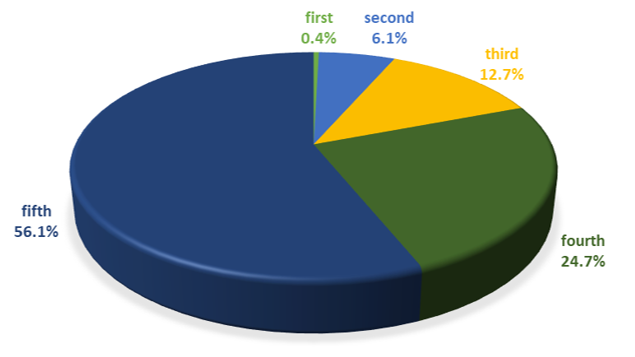

This policy brief is based on the paper: Colabella A., Guglielminetti E. and C. Rondinelli (2023), The distribution and use of Italian households’ savings after the pandemic, Questioni di Economia e Finanza (Occasional Papers) 797, Bank of Italy. The views expressed herein do not reflect those of the Bank of Italy.
The COVID-19 pandemic caused a large decline in Italian households’ consumption, a sharp increase in their propensity to save and the accumulation of financial assets. We quantify the resources saved during the pandemic and investigate their distribution across households. We estimate that the additional financial assets still exceeded €80 billion as of June 2023; while all households, including the less affluent ones, accumulated some excess savings, around 60 per cent of them were held by the highest-income quintile. Evidence based on the Consumer Expectations Survey suggests that the impulse to total consumption coming from the draw-down of excess savings by low-income individuals may have been exhausted by mid-2023. At the same time, the strong recovery in consumer credit and the hefty increase in leisure-related expenses by wealthier households could continue to support consumption of services.
Following the outbreak of COVID-19, private consumption fell dramatically and the saving rate spiked worldwide. In the second quarter of 2020 the saving rate more than doubled in Italy, to above 20 per cent, and remained significantly above pre-pandemic levels until the summer of 2022, followed by a steady decline. The dramatic surge in savings observed during 2020 and 2021 led many scholars to speak about “excess savings” (Aladangady et al. 2022, Abdelrahman and Oliveira 2023, Battistin et al. 2023, de Soyres et al. 2023), broadly defined as the difference between observed savings and a counterfactual scenario where savings are assumed to evolve according to historical regularities. For the Italian case we assume that households kept saving at a rate in line to that prevailing in the 5 years before the pandemic.
Given that residential wealth in Italy was rather stable during the pandemic and early post-pandemic periods and there was no abrupt drop in household debt, it is fair to assume that the additional savings were invested in financial assets. Moreover, savings and financial assets showed a high and stable level of correlation, notwithstanding the pandemic shock. Exploiting such regularity, we calculated both actual and counterfactual financial assets.

Notes: our computations on Bank of Italy and Eurostat data. Raw quarterly data: moving averages of four terms.
From the second quarter of 2020 until the spring of 2022 the flow of households’ financial assets was considerably higher than the counterfactual one, with a peak difference of more than 25 billion euros at the beginning of 2021. Between the onset of the pandemic and June 2022 the stock of excess savings accumulated in financial assets increased to 122 billion euros, and was still around 84 billion in the second quarter of 2023 (Figure 1). This amount corresponds to 1.6 per cent of households’ stock of financial assets and slightly more than 4 per cent of annual GDP.
Yet, the total amount of additional financial assets accumulated during the pandemic was distributed unevenly across households based on their income distribution. Data from the Bank of Italy Survey on Households Income and Wealth (SHIW) on the distribution of financial assets by quintiles of net disposable income show that the propensity to save varies across households and increased to different degrees during the pandemic. By assuming a propensity to save for each quintile of income equal to that recorded in the 2016 SHIW, the last wave before the outbreak of the public health crisis, it appears that at the end of 2020 – the last available survey – aggregate excess savings amounted to nearly 88 billion euros, with the lion’s share (around 60 per cent) being concentrated in the upper quintile; at the same time, only around 6.5 per cent belonged to the two lowest quintiles of the income distribution (Figure 2). Low-income households recorded nonetheless positive, although limited, savings, which they would not have obtained otherwise.

Notes: our computations on Survey on Households Income and Wealth in 2020 and National accounts.
The moderate fall in the stock of excess financial assets since mid-2022 suggests that these resources might have contributed somewhat to the recovery in consumption. At the same time, in light of the distribution of excess financial assets (concentrated in high-income classes), this support cannot be taken for granted in the near future. The assessments of the Italian households interviewed for the monthly ECB’s Consumer Expectations Survey, indeed, confirm these conclusions and help formulate some considerations on future developments.
Between mid-2021 and end-2022, a period characterised by high inflation, the share of households who did not expect to save in the next 12 months increased especially for the least well-off (first quintile of the income distribution; Figure 3, panel a) and, despite the recent decline, their share remains still above 2021 levels. This suggests that the impulse to consumption coming from the draw-down of excess savings by low-income individuals – who usually have a higher propensity to consume – may have been exhausted, given the limited amount of additional financial assets accumulated. Additionally, in real terms, financial assets came back to pre-pandemic levels in early 2023. The erosion of the real value of net financial wealth due to the inflation was heterogeneous across households (Infante et al., 2023): while capital losses were small for the least affluent households, they exceeded one-tenth of annual disposable income for the wealthiest group.
On a more positive note, the survey indicates that consumption is likely to be sustained by the increased expenditure by the wealthier households, in particular on leisure-related items (Figure 3, panel b), possibly because the amount of savings already piled-up is considered to be enough. Moreover, consumer credit has apparently held up during the monetary policy tightening cycle, and has returned to sustained growth rates comparable to those prevailing before the pandemic. Along with the decrease in the propensity to save recorded in recent months, these factors might support consumption in the months to come.

Notes: our computations on ECB Consumer Expectation Survey. Quarterly data.
Abdelrahman, Hamza and Luiz E. Oliveira (2023). “Excess No More? Dwindling Pandemic Savings.” SF Fed blog, San Francisco FED.
Aladangady, Aditya, David Cho, Laura Feiveson, and Eugenio Pinto (2022). “Excess Savings during the COVID-19 Pandemic.” FEDS notes, FED Board.
Battistini, Niccolò, Virgina Di Nino, and Johannes Gareis (2023). “The consumption impulse from pandemic savings – does the composition matter?” ECB Economic Bulletin Boxes 4.
De Soyres, Francois, Dylan Moore, and Julio Ortiz (2023). “Accumulated Savings During the Pandemic: An International Comparison with Historical Perspective.” FEDS notes, FED Board.
Infante, Luigi, David Loschiavo, Andrea Neri, Matteo Spuri, and Francesco Vercelli (2023). “The heterogeneous impact of inflation across the joint distribution of household income and wealth.” Questioni di Economia e Finanza (Occasional Papers) 738, Bank of Italy.